Learn how to inject Mounjaro with this step by step guide.
Mounjaro is the latest self-injectable weight loss medicine designed for weekly use at home. It is designed to be given by subcutaneous injection, which means you don’t have to push the needle in too far. You can easily administer it yourself or with assistance from someone else. The recommended injection sites are your abdomen (stomach), upper thighs, or the back of your upper arm (if assisted by another person). In this blog you will learn how to inject Mounjaro safely with our step by step guide.
This guide covers all the essential information about injecting Mounjaro, including how to choose the best injection site and what steps to take after administering your dose.
But before we start, we will go over some basics about Mounjaro.
Table of contents
- What is Mounjaro?
- How effective is Mounjaro
- Mounjaro weekly weight loss table
- What strengths of Mounjaro are available?
- Mounjaro dosing schedule
- Mounjaro the weekly injection for weight-loss
- What does subcutaneous mean?
- What is a subcutaneous injection?
- Mounjaro injection sites
- Where to inject Mounjaro
- Getting ready for your Mounjaro injection
- Mounjaro pre injection steps
- How to inject Mounjaro: A step-by-step guide
- Priming the Mounjaro pen
- Mounjaro injection steps
- How to store your Mounjaro pen
- Post-injection
- How to minimise pain during and after injecting Mounjaro
- Reactions at Mounjaro injection sites
- What are the differences between a subcutaneous injection and intramuscular injection?
- Tips for successful weight loss with Mounjaro
- Medical Mojo’s tailored weight loss program
-
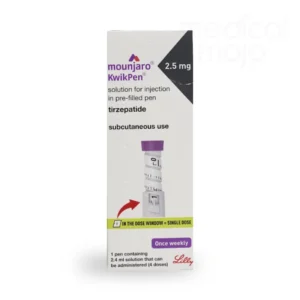 Mounjaro 2.5mg Injection£145.99 – £565.99
Mounjaro 2.5mg Injection£145.99 – £565.99 -
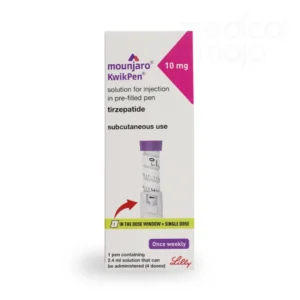 Mounjaro 10mg Injection£185.99 – £735.99
Mounjaro 10mg Injection£185.99 – £735.99 -
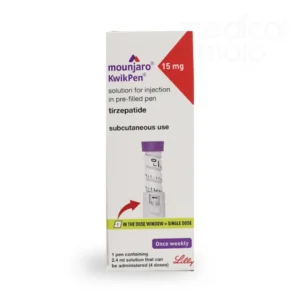 Mounjaro 15mg Injection£229.99 – £899.99
Mounjaro 15mg Injection£229.99 – £899.99
What is Mounjaro?
Mounjaro is a widely used weekly injection for weight loss that helps reduce appetite, making it easier to stick to a calorie-controlled diet.
Mounjaro, the brand name for tirzepatide, is a newly approved weekly weight loss injection, authorised by the UK’s Medicines and Healthcare Products Regulatory Agency (MHRA) in November 2023. It is licensed for adults with obesity (BMI 30) or those who are overweight (BMI 27–30) with a weight-related health conditions (MHRA 2023).
Tirzepatide, Mounjaro’s active ingredient, supports weight loss by regulating appetite. It helps you feel fuller for longer, reduces hunger, and minimises food cravings (MHRA 2023).
Tirzepatide is the first medication to combine two gut hormones: glucagon-like peptide-1 (GLP-1) and glucose-dependent insulinotropic polypeptide (GIP). Known as incretins, these hormones stimulate insulin release in response to food intake. By combining GLP-1 and GIP, Mounjaro is referred to as a “twincretin.”
This dual action enhances appetite suppression, prolongs satiety, and slows gastric emptying. Together, GLP-1 and GIP deliver a more powerful effect, leading to significant weight loss (Coskun T et al., 2018).
How effective is Mounjaro
A large-scale clinical trial called the SURMOUNT 1 trial evaluated the weight loss potential of Mounjaro (tirzepatide) in non-diabetic individuals with obesity (BMI 30 kg/m²) or those who are overweight (BMI 27 kg/m²) with at least one weight-related condition, such as high blood pressure. Over the 72-week study, participants taking the highest dose of Mounjaro (15 mg) achieved an average weight loss of 22.5% of their body weight, with nearly 90% of participants losing at least 5% of their starting weight.
These results were groundbreaking, with weight reductions of up to 22.5% observed on the 15 mg dose of Mounjaro. This significantly outperformed older FDA- and MHRA-approved weight loss treatments like orlistat, which typically produce weight loss of 3.0% to 8.6%. Even compared to the more recent GLP-1-based weight loss medication, semaglutide, which achieves average weight loss of 12.4% (Wilding JPH et al., 2021), Mounjaro demonstrated remarkable effectiveness at inducing weight-loss(American Diabetes Association Professional Practice Committee, 2022).
The table below summarises the weight loss results from the SURMOUNT-1 trial.
Mounjaro weekly weight loss table
| Week | Tirzepatide (5mg) | Tirzepatide(10mg) | Tirzepatide (15mg) | Placebo |
| 0 | 105 kg | 105 kg | 105 kg | 105 kg |
| 4 | 101 kg | 100.5 kg | 100 kg | 104.5 kg |
| 8 | 96.5 kg | 95.5 kg | 95 kg | 104 kg |
| 12 | 93.5 kg | 91.5 kg | 90 kg | 103.5 kg |
| 16 | 91.5 kg | 89 kg | 87 kg | 103 kg |
| 24 | 90 kg | 86 kg | 84.5 kg | 102.5 kg |
| 36 | 89.3 kg | 84.5 kg | 83 kg | 102.4 kg |
| 48 | 89 kg | 83.5 kg | 82 kg | 102.4 kg |
| 72 | 88.6 kg | 82.6 kg | 81.2 kg | 102.4 kg |
Studies reveal that the highest maintenance dose of Mounjaro, 15mg per week, can support weight loss of up to 22.5% of a person’s starting body weight.
Summary of total weight loss after 72 weeks with Mounjaro
- 5 mg Tirzepatide: 16.4 kg (36.1 lbs)
- 10 mg Tirzepatide: 22.4 kg (49.4 lbs)
- 15 mg Tirzepatide: 23.8 kg (52.5 lbs)
- Placebo: 2.6 kg (5.7 lbs)
Have questions about Mounjaro?
Get a FREE telephone consultation with one of our pharmacists, who will call you and help you understand what the right options are for you.
Call me about Mounjaro
What strengths of Mounjaro are available?
Mounjaro dosing schedule
- Starting dose: You begin with the Mounjaro 2.5mg dose once a week for the first four weeks.
- Dose increase: After the first four weeks on the Mounjaro 2.5mg, you move to the Mounjaro 5mg injection.
- Further adjustments: If your healthcare provider advises, the dose can be gradually increased at four-week intervals, up to a maximum of Mounjaro 15mg weekly.
This step-by-step increase allows your body to adjust to the medication and reduces the risk of side effects. Studies have shown that most side effects occur during this adjustment phase as the body adapts to Mounjaro (Jastreboff et al., 2022).
Mounjaro the weekly injection for weight-loss
Mounjaro is given as a weekly subcutaneous injection. For many, the thought of administering an injection is daunting, I mean our body is not meant to be a pin cushion. I too had a fear of needles but after administering thousands of intra muscular injections, I soon came to appreciate how simple and relatively painless subcutaneous injections are.
What does subcutaneous mean?
Subcutaneous (SC) tissue lies just beneath the skin and serves multiple purposes, such as storing energy, keeping the body hydrated, regulating temperature, and acting as a cushion to protect muscles and bones (N. Alkhouli, et al., 2013). It is made up of two layers: loose connective tissue (also called areolar tissue) and adipose (fat) tissue (L. Allen, et al., 2011).
Although unlike the muscle which has a rich blood supply, the subcutaneous tissue has a less extensive supply of blood vessels that keep it healthy and nerve fibres that give the skin its ability to sense touch, temperature, and pain (N. Sans, et al., 2011). It also contains a network of lymphatic vessels that help drain excess fluid. Unlike the digestive system, subcutaneous tissue has minimal enzyme activity, which means injected drugs are not broken down as they might be if taken orally (N. Sans, et al., 2011).
| Week | Tirzepatide (5mg) | Tirzepatide(10mg) | Tirzepatide (15mg) | Placebo |
| 0 | 231 lbs | 231 lbs | 231 lbs | 231 lbs |
| 4 | 222.2 lbs | 221.3 lbs | 220.5 lbs | 230 lbs |
| 8 | 212.7 lbs | 210.5 lbs | 209.4 lbs | 229 lbs |
| 12 | 206 lbs | 201.6 lbs | 198.4 lbs | 228 lbs |
| 16 | 201.6 lbs | 196.2 lbs | 191.8 lbs | 227 lbs |
| 24 | 198.4 lbs | 189.6 lbs | 186.2 lbs | 226 lbs |
| 36 | 196.8 lbs | 186.3 lbs | 183 lbs | 225.8 lbs |
| 48 | 196.2 lbs | 184 lbs | 180.7 lbs | 225.8 lbs |
| 72 | 195.3 lbs | 182.1 lbs | 179 lbs | 225.8 lbs |
-
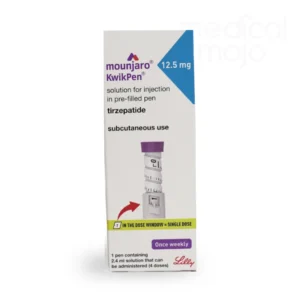 Mounjaro 12.5mg Injection£229.99 – £899.99
Mounjaro 12.5mg Injection£229.99 – £899.99 -
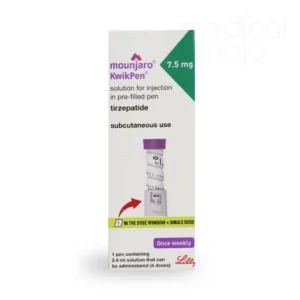 Mounjaro 7.5mg Injection£185.99 – £735.99
Mounjaro 7.5mg Injection£185.99 – £735.99 -
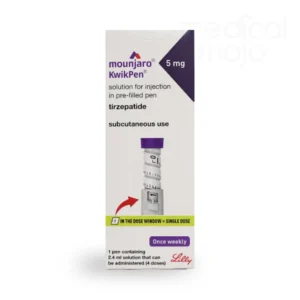 Mounjaro 5mg Injection£145.99 – £565.99
Mounjaro 5mg Injection£145.99 – £565.99
What is a subcutaneous injection?
Because of these properties of the subcutaneous tissue it makes it an ideal site for delivery of certain medications, like biopharmaceuticals such as Mounjaro, which are not effective when taken by mouth due to poor absorption or breakdown in the stomach.
So, the subcutaneous (SC) injection is a method of delivering medication into the fatty tissue layer just beneath the skin. Subcutaneous tissue has a less extensive blood supply compared to muscle, resulting in slower absorption of drugs administered via this route compared to intramuscular injections (Dougherty and Lister, 2015). This slower absorption rate can be advantageous for medications requiring steady, prolonged delivery, such as insulin, heparin and now Mounjaro (Hunter, 2008). This method is suitable for administering small volumes (up to 2ml) of water-soluble, non-irritating medications (Dougherty and Lister, 2015).
Are subcutaneous injections painful?
Subcutaneous injections are generally not very painful. Most people describe the sensation as a small pinch or slight sting when the needle is inserted. The discomfort is typically minimal because the injection is administered into the fatty layer just beneath the skin, which contains fewer nerve endings compared to deeper tissues.
However, pain levels can vary based on factors such as the medication being injected, the needle size, the injection technique, and individual sensitivity. Rotating injection sites and ensuring proper technique can help minimise discomfort.
Another technique to reduce the pain associated with subcutaneous injections is not to rush. A 2017 Cochrane review found that injecting subcutaneous heparin slowly, over about 30 seconds, might help reduce pain compared to a quicker injection. However, it didn’t make any difference in the amount of bruising caused by the injection (Mohammady M et al.,2017)
If persistent pain or significant irritation occurs, it’s a good idea to consult a healthcare provider, or contact us for a FREE Mounjaro weight-loss consultation.
Mounjaro injection sites
When using Mounjaro, it’s important to choose the right injection site. The medication is injected just under the skin (subcutaneously) in one of the following areas:
- Stomach (abdomen)
- Upper thigh
- Upper arm – assistance may be needed for this site.
Where to inject Mounjaro
When administering Mounjaro yourself, you can inject into your abdomen or upper thighs. You can inject into the upper arms only if there is someone there to help you inject.
To ensure proper rotation, divide the injection site into two sections on each side of your body (refer to the diagram for guidance). Alternate the injection site each week so that you don’t use the same area again for at least four weeks.
For abdominal injections, always maintain a gap of at least 5 cm from your belly button. Additionally, make sure each injection is placed at least one finger width away from the previous injection site.

You can inject in the same general area each week but should rotate the specific spot within that area. Alternatively, you can switch between locations each week. For example, you might use your stomach in week 1, upper thigh in week 2, and upper arm in week 3, and so on.
As you become familiar with the process, you’ll discover which site works best for you.
Getting ready for your Mounjaro injection
Before using Mounjaro, take a few simple steps to prepare, the first of which is to check that the Mounjaro pack has the following:
Your Mounjaro package will include:
- A pre-filled injection pen containing 4 weekly doses.
- A patient information leaflet.
- An instruction guide on how to use Mounjaro.
Before your first injection:
- Carefully read both the patient information leaflet and the instruction guide.
- Decide on a convenient day and time each week for your injections and stick to it.
If you have ordered your Mounjaro injection from Medical Mojo, then you will also receive the 4mm needles to attach to the pen and a sharps box to dispose of the used needles safely. The needles and sharps bin are supplied FREE with your order of the Mounjaro pen.
Be consistent with your Mounjaro injections
Injecting Mounjaro on the same day each week is important because it:
- Maintains a steady level of medication in your body, ensuring optimal effectiveness.
Mounjaro pre injection steps
- Wash your hands: Use warm, soapy water to clean your hands thoroughly, then dry them.
- Confirm the dosage: Check that the correct dose is indicated on the original packaging and verify that it is within its expiration date.
- Inspect the pen and the contents: Remove the pen from its box and check for any visible damage. Remove the protective cap and inspect the liquid in the dosage window. Ensure it’s clear and free from debris or particles. If the solution appears frozen or cloudy, do not use it.
- Prepare a new needle: Have a new, sealed needle ready for use. Ensure it is not unsealed, bent, or damaged in any way.
How to inject Mounjaro: A step-by-step guide
The Mounjaro ‘KwikPen’ is a single-patient-use pen that contains four fixed doses, with one dose injected each week. This means that each pen provides 4 weeks of treatment. Once all four doses are used, the pen should be discarded.
After completing steps 1 to 4 from the ‘Mounjaro pre injection steps’ section, follow these steps to administer your medication:
Priming the Mounjaro pen
- Clean the inner red seal: Use a clean alcohol swab to wipe it.
- Select a new needle: Always use a fresh needle for each injection. Ensure it is not bent or damaged and remove the paper tab from the outer needle shield. You will receive FREE needles for each Mounjaro pen ordered from Medical Mojo.
- Attach the needle: Push the capped needle straight onto the pen and twist it clockwise until it is tightly secured. Remove the outer needle shield and set it aside for later use. Take off the inner needle shield and dispose of it in your household waste.
- Set the pen to prime position: Slowly turn the dose knob until you hear two clicks and see the extended line in the dose window. Adjust the knob as needed to align with the dose indicator.
- Remove air bubbles: Hold the pen upright with the needle pointing up. Gently tap the cartridge holder to bring air bubbles to the top.
- Prime the pen: Push the dose knob until it stops and slowly count to 5. The ‘0’ icon should appear in the dose window. If you see a small drop of medication at the needle tip, your pen is primed.
- If no medication comes out, repeat steps 4 to 6 up to two more times. If unsuccessful, change the pen needle and repeat these steps one more time. If the issue persists, please contact us or your doctor.
Mounjaro injection steps
- Select an injection site: Choose your abdomen, upper thigh, or upper arm (if someone is assisting). No need to pinch or squeeze the skin.
- Set the dose: Turn the dose knob until it stops, showing the ‘1’ icon in the dose window, representing a single 0.6ml dose.
- Insert the needle and deliver the dose: Push the needle into your skin at the chosen injection site. Make sure the dose counter is visible. Push the dose knob all the way in and count to 5 while holding it in place. Confirm the ‘0’ icon appears in the dose window before removing the needle.
- Remove the needle: Pull the needle out. A small drop of medicine at the needle tip is normal and won’t affect the dose.
- If the ‘0’ icon does not appear, reinsert the needle to complete the injection. Do not redial the dose. Contact us or your doctor if unsure.
After the Injection
- Dispose of the needle: Carefully replace the outer needle shield and discard the used needle in a sharps bin.
- Store your pen: Replace the pen cap and store it until your next dose.
By following these steps, you can safely and effectively administer your Mounjaro treatment. If you have any questions, please contact us.
How to store your Mounjaro pen
- Room temperature storage: You can store your opened Mounjaro pen at room temperature (up to 30°C) for a maximum of 30 days. Keep it in its original packaging and away from direct light.
- Refrigeration: Alternatively, you can store it in a fridge between 2°C and 8°C. When stored in the fridge, it doesn’t need to be discarded after 30 days as long as the temperature guidelines are followed.
- Do not freeze: If the Mounjaro pen has been frozen, DO NOT USE.
Post-injection
After injecting Mounjaro, it’s normal to notice a small amount of blood at the injection site. Simply press gently with a piece of gauze or cotton wool to stop the bleeding.
You might also experience slight bruising around the injection area. This is common and should fade within a few days. If you’re concerned or notice persistent issues, consult your healthcare provider or contact us.
How to minimise pain during and after injecting Mounjaro
To reduce discomfort and irritation while injecting Mounjaro, try the following tips:
- Don’t rush the injection. A 2017 Cochrane review found that administering subcutaneous heparin slowly, over approximately 30 seconds, may help reduce injection-related pain compared to a faster injection. However, this technique did not appear to affect the likelihood or severity of bruising (Mohammady M et al.,2017) .
- If you get irritation at the injection site, try taking an antihistamine tablet or use an antihistamine cream.
- Rotate your injection site weekly to avoid irritation in the same area.
- Clean the skin thoroughly with a swab before injecting.
- Apply an ice pack to numb the area and reduce irritation before the injection.
- Take over-the-counter pain relief, such as paracetamol, if you feel sore after injecting.
- Apply a cold compress to the site to reduce swelling after the injection.
These strategies can help make the injection process smoother and more comfortable.
Reactions at Mounjaro injection sites
Some people may experience mild reactions at the site of their Mounjaro injection.
Injection site reactions were observed across several studies. For those taking a placebo, injection site reactions were reported in about 1.15% of participants. Mounjaro injection site reactions increased slightly with higher doses: 1.89% for the 5 mg dose, 2.44% for the 10 mg dose, and 3.11% for the 15 mg dose. This shows that injection site reactions are uncommon and occur slightly more frequently with higher doses of Mounjaro (Mishra, R et al., 2023).
Common injection site reactions include:
- Skin rashes
- Itching
- Eczema
- Swelling
- Redness
If you notice any of these reactions, inform your doctor. They might recommend adjusting your dose, switching injection sites, or using an over-the-counter cream to ease irritation.
While injecting Mounjaro should not cause significant pain, severe swelling, redness, or irritation could indicate an allergic reaction. If you experience these symptoms, seek medical attention immediately.
What are the differences between a subcutaneous injection and intramuscular injection?
The main differences between subcutaneous (SC) and intramuscular (IM) injections relate to the depth, site, absorption rate, and typical uses, with variations in needle sizes measured in millimetres (mm):
1. Injection Site and Depth
Subcutaneous Injection (SC):
- Delivered into the fatty layer just beneath the skin.
- Common sites: abdomen, upper arm, thigh, or buttocks.
- Needle length: shorter needles, typically 4–16 mm.
- Examples: Insulin, heparin, certain vaccines, Wegovy and Mounjaro.
Intramuscular Injection (IM):
- Administered deeper, directly into the muscle tissue.
- Common sites: deltoid (upper arm), vastus lateralis (thigh), or gluteus maximus (buttocks).
- Needle length: longer needles, generally 25–40 mm, to ensure it reaches the muscle.
- Examples: Vaccines (e.g., flu shot), hormonal treatments, and some antibiotics.
2. Absorption Rate
Subcutaneous (SC):
- Slower absorption as the medication diffuses gradually into the bloodstream from the fat layer.
- Best for medications requiring a steady, prolonged release.
- Examples: Insulin, which acts over hours or days and Mounjaro which lasts for a week.
Intramuscular (IM):
- Faster absorption due to the rich blood supply in muscles.
- Suitable for medications requiring quick action.
- Examples: Emergency vaccines or pain-relieving injections.
3. Pain and Sensation
Subcutaneous (SC):
- Typically less painful since the fatty layer contains fewer nerve endings.
- Thin needles (4–16 mm) contribute to reduced discomfort.
Intramuscular (IM):
- Can be more uncomfortable or painful as muscles have more nerve endings and require deeper penetration.
- Uses thicker, longer needles (25–40 mm) to ensure delivery to the muscle.
4. Volume of Medication
Subcutaneous (SC):
- Designed for smaller volumes, usually up to 1–2 milliliters (mL).
- Larger amounts can cause irritation or pain.
Intramuscular (IM):
- Accommodates larger volumes, typically up to 3–5 mL depending on the site and patient.
- Suitable for medications requiring larger doses.
5. Common Uses
Subcutaneous (SC):
- Hormones (e.g., insulin, growth hormone).
- Blood thinners (e.g., heparin).
- Certain vaccines (e.g., MMR).
- Weight-loss injections (e.g., Wegovy, Mounjaro).
Intramuscular (IM):
- Vaccinations (e.g., tetanus, flu).
- Long-acting medications (e.g., Depo-Provera).
- Emergency medications (e.g., epinephrine-Epipen).
Is Mounjaro right for you?
Get a FREE telephone consultation with one of our pharmacists.
Call me about Mounjaro
Mounjaro (tirzepatide) and Wegovy (semaglutide) are administered by injection because their active ingredients are peptide-based drugs, which are not suitable for oral delivery. Here’s why they are given by injection:
1. Poor oral bioavailability
Peptide-based medications like tirzepatide and semaglutide are large molecules that would be broken down by enzymes in the digestive tract if taken orally. The stomach and intestines degrade these compounds into smaller, inactive fragments, making them ineffective when swallowed. (Source:Drucker, 2020)
2. Long-acting formulation
Both Mounjaro and Wegovy are designed to be long-acting treatments, with effects lasting for a week after a single dose. Subcutaneous injections enable the drug to be absorbed slowly over time from the fatty tissue, ensuring sustained release and activity. Oral formulations would require much more frequent dosing, which may lead to lower patient compliance.
The injection route ensures these medications maintain their potency and deliver the intended therapeutic effects effectively.
You should rotate your Mounjaro injection site every week to prevent irritation or the buildup of fatty tissue. You can:
Use the same general area, such as the stomach or thigh, but select a different section of skin each week.
Alternate areas entirely, for instance, injecting in the stomach one week, the thigh the next, and so on.
Mounjaro injections may cause slight discomfort or a pinch-like sensation when the needle enters the skin. However, most people find the pain to be minimal and manageable.
No, it’s important to change your injection site each week. Repeatedly injecting into the same spot increases the risk of pain, irritation, swelling, or other site reactions.
NO! Allows use a clean needle to inject. You don’t have to worry about needle supplies when you order from Medical Mojo, as each order of Mounjaro comes with FREE needles.
Mild redness, swelling, bruising, or itching at the injection site is common and typically resolves on its own. As your body adjusts to Mounjaro, these reactions often decrease. If the reaction persists, try a different injection site as some areas may be more sensitive than others.
Mounjaro has a dose escalation process that is designed to allow your body to get used to the medicine so that you experience fewer side effects. So, you start with the Mounjaro 2.5mg injection for four weeks before moving up in dose to the Mounjaro 5mg. Every four weeks you can increase the strength of Mounjaro. If you are experience side effects at the higher dose and they don’t subside, you can drop down to the lower dose, so long as you were losing weight at this dose.
Tips for successful weight loss with Mounjaro
Maximise your weight loss journey with Mounjaro by following these practical tips:
1. Aim for a 600-calorie deficit
To effectively lose weight, aim for a daily calorie deficit of around 600 calories compared to your recommended intake (different for men and women). Mounjaro makes this easier by curbing hunger and increasing fullness.
- Start gradually—reduce 100 calories a week until you reach your target.
- Use calorie-tracking apps to stay on track.
Want to know how much weight you can lose while on Mounjaro, have a read of our blog, Mounjaro weight loss week by week.
2. Focus on balanced, healthy eating
Build balanced meals with whole, nutrient-rich foods:
- Include: Fruits, vegetables, lean protein, and whole grains.
- Limit or avoid: Sugary, processed, high-fat, and calorie-dense foods.
- Add small portions of healthy fats like nuts, seeds, or olive oil.
- Increase your protein intake to preserve muscle mass during weight loss.
If you have any more questions about taking Mounjaro, such as:
Check out Mojo Guide for our blogs.
3. Get moving
Incorporate regular exercise into your routine—choose activities you enjoy to stay consistent.
- Aim for activities that keep you active and engaged.
- Check the NHS guidelines- Physical activity guidelines for adults aged 19 to 64 for tips tailored to your fitness level.
- Remember, exercise complements Mounjaro.
4. Prioritise Sleep
Quality sleep is essential for weight loss. Aim for at least 8 hours per night.
Struggling with sleep? Explore our blogs like Fifteen tips for healthy sleep or try relaxing methods like ASMR, which you can read about or listen at What is ASMR, and can it help you sleep?
Consistently getting less than 6 hours of sleep can lead to weight gain (Knutson K.L et al., 2008). Even short-term sleep restriction can cause temporary weight gain, and research links poor sleep to long-term weight gain in adults and children (McNeil J et al., 2017).
Sleep is the “secret sauce” for weight loss. It recharges your energy, reduces cravings, and supports healthier food choices and physical activity.
5. Stay Consistent and Balanced
- Consistency: Sustainable weight loss takes time—the best results from the Surmount 1 trial occurred after 72 weeks. Think of it as a marathon, not a sprint.
- Balance: Even when eating less, ensure your diet includes enough proteins, vitamins, and minerals for optimal body function.
Be the tortoise, not the hare. With Mounjaro, a balanced diet, and healthy habits, you can achieve long-term, sustainable weight loss.
For more personalised advice, contact Medical Mojo for your FREE Mounjaro weight loss consultation.
Are weight loss treatments making you tired, or have they led to a sudden increase in hair loss? Do you struggle with sleep?
Get a free month’s supply of one of our compounded treatments for energy, hair loss or sleep, with your first purchase of Mounjaro or Wegovy from Medical Mojo.
Claim your FREE offer
Medical Mojo’s tailored weight loss program
At Medical Mojo, we provide a comprehensive weight loss coaching service to support your journey to success. Our program includes:
- Weekly calls to review progress and stay motivated.
- Expert guidance to set realistic and achievable goals.
- Personalised strategies to help maximize your weight loss results.
- Offer personalised coaching to support your progress.
- Include FREE needles and sharps bins, making it easy for you to start right away.
Our supportive coaching program is designed to keep you motivated and empowered, helping you achieve sustainable, long-term weight loss.
Start Your Journey Today
Let Medical Mojo guide you toward the results you deserve. With expert support, personalised plans, and access to resources, weight loss has never been more achievable.
Note: This information is for educational purposes only and should not substitute for professional medical advice.
References
- N. Alkhouli, J. Mansfield, E. Green, J. Bell, B. Knight, N. Liversedge, J.C. Tham, R. Welbourn, A.C. Shore, K. Kos, C.P. Winlove. The mechanical properties of human adipose tissues and their relationships to the structure and composition of the extracellular matrix. Am. J. Physiol. Endocrinol. Metab., 305 (2013), pp. E1427-E1435
- L. Allen, V. Popovich, N.G. Ansel, C. Howard. Ansel’s Pharmaceutical Dosage Forms and Drug Delivery Systems. Wolters Kluwer Health/Lippincott Williams & Wilkins, Philadelphia (2011)
- American Diabetes Association Professional Practice Committee, 2022. 8. Obesity and weight management for the prevention and treatment of type 2 diabetes: standards of medical care in diabetes-2022. Diabetes care, 45(Suppl 1), pp.S113-S124.
- Coskun T, Sloop KW, Loghin C, Alsina-Fernandez J, Urva S, Bokvist KB, et al. LY3298176, a novel dual GIP and GLP-1 receptor agonist for the treatment of type 2 diabetes mellitus: from discovery to clinical proof of concept. Mol Metab. 2018;18:3–14. doi: 10.1016/j.molmet.2018.09.009.
- Dougherty L, Lister S (2015) The Royal Marsden Manual of Clinical Nursing Procedures. Oxford: Wiley-Blackwell.
- Hunter J (2008) Subcutaneous injection technique. Nursing Standard; 22: 21, 41-44.
- Knutson K.L., Van Cauter E. Associations between Sleep Loss and Increased Risk of Obesity and Diabetes. Ann. New York Acad. Sci. 2008;1129:287–304.
- McNeil J., St-Onge M.P. Increased Energy Intake Following Sleep Restriction in Men and Women: A One-Size-Fits-All Conclusion? Obesity. 2017;25:989–992.
- MHRA, 2023. MHRA authorises diabetes drug Mounjaro (tirzepatide) for weight management and weight loss. GOV.UK. Available at: https://www.gov.uk/government/news/mhra-authorises-diabetes-drug-mounjaro-tirzepatide-for-weight-management-and-weight-loss [Accessed 30 Nov. 2024].
- Mishra, R., Raj, R., Elshimy, G., Zapata, I., Kannan, L., Majety, P., Edem, D. and Correa, R., 2023. Adverse events related to tirzepatide. Journal of the Endocrine Society, 7(4), p.bvad016.
- Mohammady M et al (2017) Slow versus fast subcutaneous heparin injections for prevention of bruising and site pain intensity. Cochrane Database of Systematic Reviews; 10: CD008077.
- N. Sans, M. Faruch, H. Chiavassa-Gandois, C.L. de Ribes, C. Paul, J.J. Railhac. High-resolution magnetic resonance imaging in study of the skin: normal patterns. Eur. J. Radiol., 80 (2011), pp. e176-e181
- Unick, J.L., Pellegrini, C.A., Dunsiger, S.I., Demos, K.E., Thomas, J.G., Bond, D.S., Lee, R.H., Webster, J. and Wing, R.R., 2024. An Adaptive Telephone Coaching Intervention for Patients in an Online Weight Loss Program: A Randomized Clinical Trial. JAMA Network Open, 7(6), pp.e2414587-e2414587.
- Wilding JPH, Batterham RL, Calanna S, et al. Once-weekly semaglutide in adults with overweight or obesity. N Engl J Med 2021;384:989-1002


